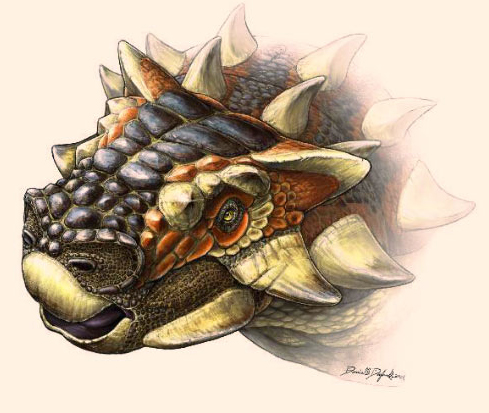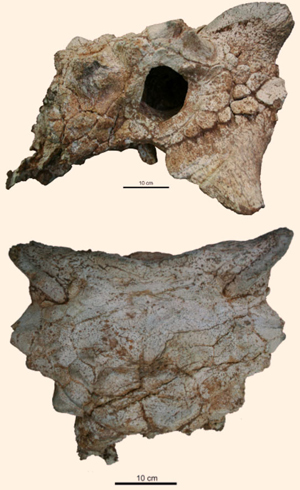Zaraapelta nomadis In Praise of Victoria Arbour
New Species of Ankylosaurid Named – Zaraapelta nomadis
There are lots of female scientists all helping to make a significant contribution within their chosen specialist fields. In palaeontology, many of the world’s top researchers are female, the gender imbalance in the sciences is slowly being altered as more and more women take up the opportunities offered by a career in academia. When it comes to the Dinosauria, we at Everything Dinosaur, have remarked on numerous occasions how the ankylosaurids and research into these heavily armoured ornithischians seems to be overshadowed by studies focused on the ceratopsian and the hadrosaurs. So it is doubly pleasing to write about the naming of a new species of ankylosaur, one that has been named by Victoria Arbour (University of Alberta).
Victoria Arbour and Ankylosaurids
Victoria’s research into Late Cretaceous ankylosaurids has been featured in a number of our blog articles over the years, she has established herself as the “go to person”, when it comes to studies into this particular branch of the armoured dinosaur family tree.
The new species has been named Zaraapelta nomadis. It is known from a nearly complete skull (missing the snout), from the Baruungoyot Formation of Mongolia. The fossil specimen was discovered in 2000 A.D. during an expedition to the Gobi Desert which was led by Professor Phil Currie (University of Alberta). The genus name is a combination of the Mongolian and the Greek for “hedgehog shield”, whilst the species name honours, the Mongolian company Nomadic Expeditions which has played a pivotal role in helping scientists to explore the Gobi Desert for dinosaur fossils.
Zaraapelta nomadis
Thanks to the work of post-doctoral researchers like Victoria, scientists are beginning to work out that there were a number of different types of ankylosaurid present in the region that was to form the Nemegt and Baruungoyot rock formations. Similar research has revealed a number of different ankylosaur genera present in North America (Dinosaur Park Formation). It seems likely that there was almost as much diversity in the ankylosaurids as there was in the ceratopsians and hadrosaurs.
Zaraapelta was certainly a very prickly customer, the new species has been erected as the skull shows some unique morphology. For example, behind the eye sockets and over the rear of the skull there is extensive ornamentation, lots of bumps and lumps of bone, to us, this dinosaur reminds us of a giant thorny devil lizard (Moloch horridus). At the back of its skull there were distinctive horns with a prominent ridge along the top, the holotype specimen is being kept at the Mongolian Palaeontological Centre, located at Ulaanbaatar.
A Spectacular Skull
The skull of Zaraapelta is even more spectacular than the other Mongolian armoured dinosaurs, the likes of Saichania (S. chulsanensis) and Tarchia (T. kielanae). In a paper published in the “Zoological Journal of the Linnean Society”, the research team, that included Professor Phil Currie and Demchig Badamgarav (Mongolian Academy of Sciences), provide a phylogenetic analysis of ankylosaurids from the Gobi desert. The scientists concluded that Z. nomadis was probably most closely related to Tarchia kielanae.
An Illustration of Zaarapelta nomadis
Picture credit: University of Alberta/Danielle Dufault
Elaborate and Distinctive Ornamentation
Doctor Arbour explained that the elaborate and distinctive ornamentation on the skulls of these ankylosaurs may have evolved as a way to show off in order to attract a mate. Head crests and extensive skull ornamentation in the ceratopsian and hadrosaurs are associated with display as well as for defence (in the case of the horned dinosaurs), but this idea is not generally applied to ankylosaurids.
Victoria stated:
“You can think of bone being an expensive item for your body to maintain. Bone requires lots of nutrients and metabolic energy to create and so that investment needs to pay off in some way. Maybe ankylosaurs had this bumpy ornamentation for protection, but another good explanation is that the horns and bumps on their skulls showed that they were a good mate to choose, in the same way that Peacocks use their tail feathers.”
The Holotype Fossil Material of Zaraapelta nomadis
Picture credit: University of Alberta
Examining Previously Named Mongolian Ankylosaurs
In addition to naming the new ankylosaur Zaraapelta, this study also re-examined previously named ankylosaurs from Mongolia and found support for “resurrecting” a species that had been discarded by earlier workers. The science of naming organisms, called taxonomy, is more fluid than many people might realise, Arbour notes. Sometimes, researchers might determine that two species names represent only one actual species, in which case the name that was created first has priority (senior synonym).
This was the case for an ankylosaur called Tarchia kielanae, which was eventually thought to be the same kind of ankylosaur as Tarchia gigantea. But new information from recent dinosaur discoveries, including this study, suggests that Tarchia kielanae might be a separate species after all, so the name has been brought back into scientific literature.
Just as the phylogenetic analysis of ankylosaurids has changed, so it is all change for Dr Arbour, next month she is taking up a new position as a post-doctoral researcher at the North Carolina Museum of Natural Sciences.
We wish her well in her new role and we look forward to writing about her future research.
For models and replicas of ankylosaurids and other dinosaurs, visit Everything Dinosaur’s award-winning website: Everything Dinosaur.



